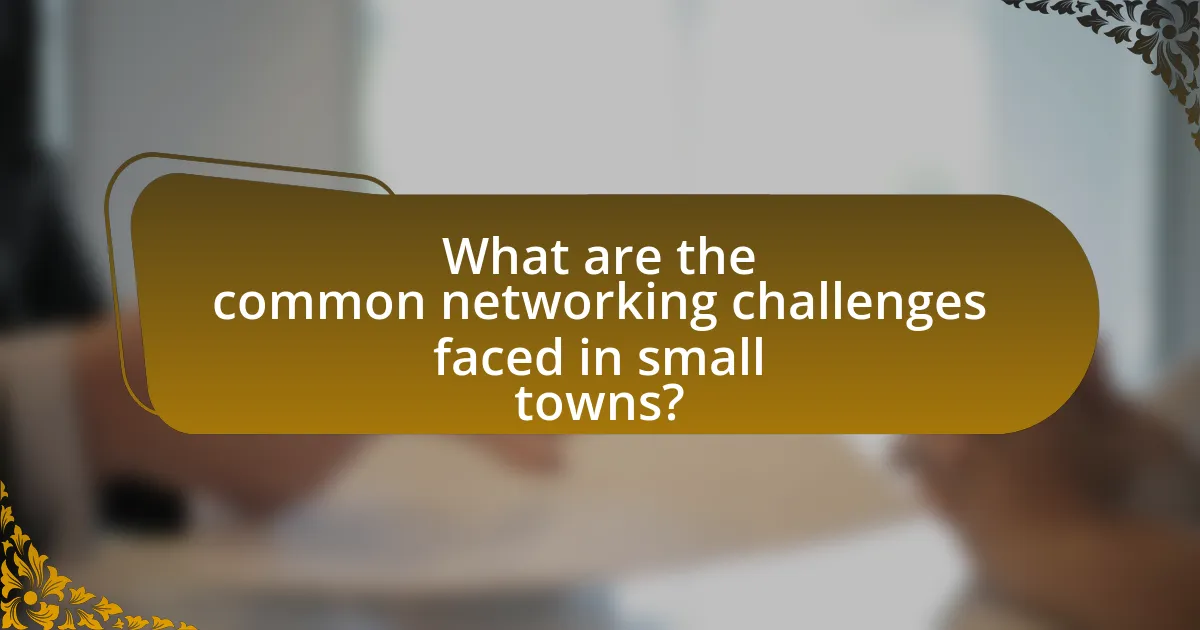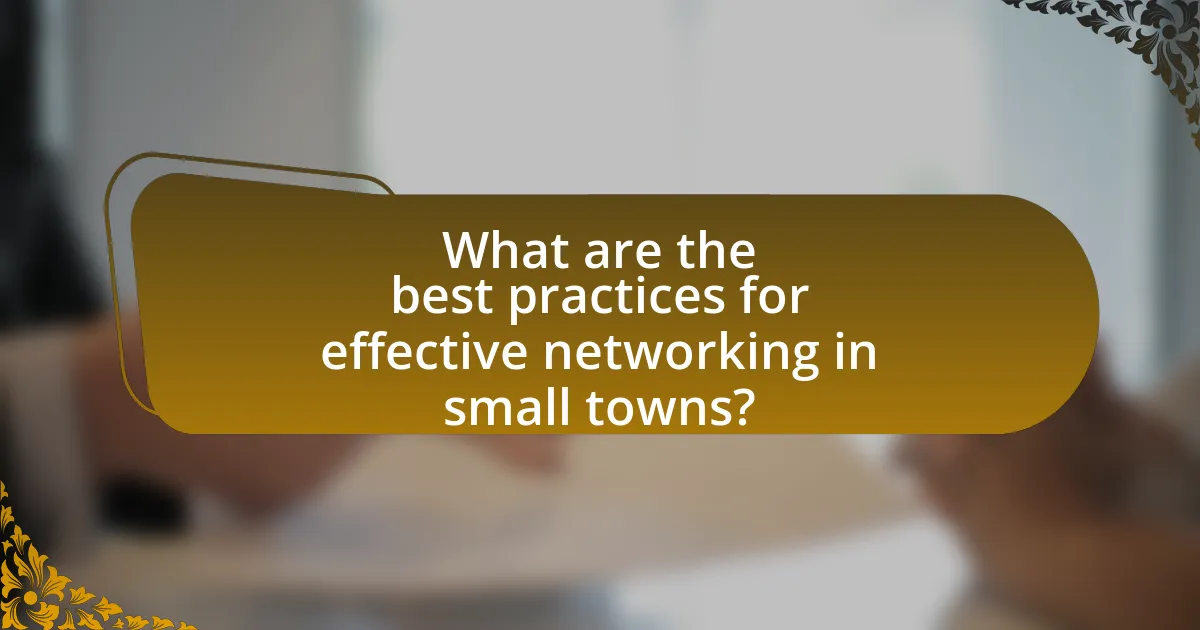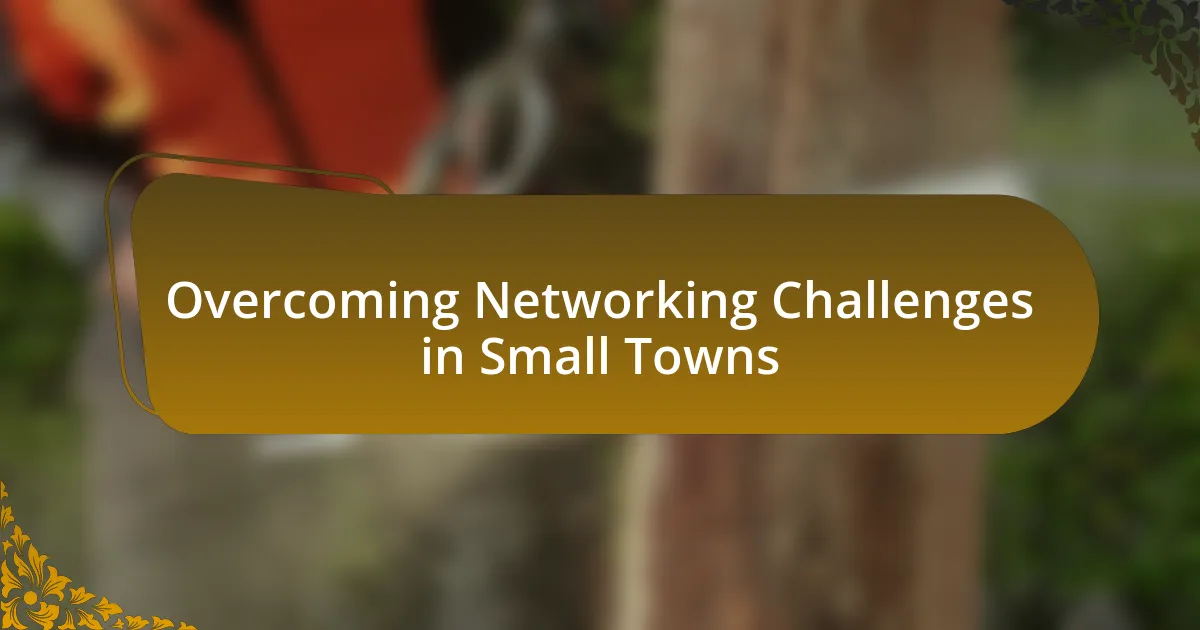The article focuses on overcoming networking challenges in small towns, highlighting issues such as limited infrastructure, lower internet speeds, and geographical limitations that hinder professional connections. It discusses how population size and local culture impact networking dynamics, emphasizing the importance of building personal relationships and leveraging community events. Strategies for enhancing networking capabilities include utilizing digital platforms, engaging in local initiatives, and fostering mentorship programs. The article also outlines best practices for effective networking, including the significance of follow-up communication and the need to avoid common pitfalls that can hinder relationship-building in smaller communities.

What are the common networking challenges faced in small towns?
Common networking challenges faced in small towns include limited infrastructure, lower internet speeds, and a lack of access to advanced technologies. These issues arise because small towns often have fewer resources allocated for telecommunications, resulting in inadequate broadband coverage. According to the Federal Communications Commission, rural areas, which often include small towns, experience significantly slower internet speeds compared to urban areas, with many residents lacking access to high-speed internet altogether. Additionally, small towns may struggle with a smaller talent pool, making it difficult to attract skilled professionals who can enhance local networking capabilities.
How do geographical limitations impact networking opportunities?
Geographical limitations significantly restrict networking opportunities by isolating individuals from broader professional communities. In small towns, limited access to diverse industries and fewer networking events reduce the chances for meaningful connections. For instance, a study by the Kauffman Foundation found that urban areas have a higher density of networking events and professional gatherings, which fosters collaboration and innovation. Consequently, individuals in geographically isolated regions may struggle to find mentors, partners, or clients, ultimately hindering their professional growth and access to resources.
What specific geographical factors contribute to networking difficulties?
Geographical factors that contribute to networking difficulties include population density, physical distance, and infrastructure limitations. In small towns, lower population density often results in fewer networking opportunities, as there are fewer individuals and businesses to connect with. Physical distance can hinder access to resources and events, making it challenging for individuals to engage with broader networks. Additionally, inadequate infrastructure, such as limited internet connectivity and transportation options, further exacerbates these difficulties by restricting communication and mobility, which are essential for effective networking.
How can small towns leverage their geographical features for networking?
Small towns can leverage their geographical features for networking by utilizing natural landmarks and local resources to create unique community events and gatherings. For instance, towns situated near rivers or mountains can organize outdoor activities such as hiking, fishing, or community picnics that attract residents and visitors, fostering connections. Additionally, towns can promote their historical sites or agricultural landscapes to host festivals or markets, which not only showcase local culture but also encourage networking among businesses and residents. Research indicates that community events significantly enhance social ties and economic collaboration, as seen in studies by the Community Development Society, which highlight the importance of place-based initiatives in strengthening local networks.
What role does population size play in networking challenges?
Population size significantly influences networking challenges by affecting resource availability, infrastructure development, and user engagement. In smaller populations, limited financial resources can hinder the establishment of robust networking infrastructure, leading to slower internet speeds and less reliable connections. For instance, according to the Federal Communications Commission, rural areas, which often have smaller populations, experience higher rates of broadband unavailability compared to urban areas. Additionally, smaller communities may struggle with lower user engagement, resulting in fewer participants in local networking initiatives, which can further exacerbate connectivity issues. Thus, population size directly correlates with the extent and severity of networking challenges faced in small towns.
How does a smaller population affect the diversity of networking connections?
A smaller population limits the diversity of networking connections by reducing the number of individuals available for interaction and collaboration. In smaller communities, the pool of potential contacts is often homogenous, leading to fewer opportunities for diverse perspectives and ideas. Research indicates that diverse networks enhance creativity and problem-solving; however, in small towns, the lack of variety in social and professional backgrounds can stifle innovation and limit access to different resources. For instance, a study by the Kauffman Foundation found that regions with larger populations tend to have more diverse entrepreneurial ecosystems, which are crucial for economic growth and resilience.
What strategies can small towns implement to expand their networking reach?
Small towns can expand their networking reach by leveraging digital platforms, organizing community events, and forming partnerships with local businesses. Digital platforms, such as social media and community websites, allow small towns to connect with a broader audience, facilitating communication and collaboration. For instance, towns can create Facebook groups or utilize platforms like Nextdoor to share information and resources. Organizing community events, such as fairs or workshops, fosters face-to-face interactions and strengthens local ties, which can lead to increased networking opportunities. Additionally, forming partnerships with local businesses can enhance visibility and create mutually beneficial relationships, as seen in initiatives where local chambers of commerce collaborate with entrepreneurs to host networking events. These strategies collectively enhance the networking capabilities of small towns, making them more connected and resourceful.
How does local culture influence networking dynamics?
Local culture significantly influences networking dynamics by shaping interpersonal relationships, communication styles, and trust levels within communities. In small towns, cultural norms often dictate how individuals approach networking, with emphasis on face-to-face interactions and long-term relationships. For instance, research indicates that in collectivist cultures, which are common in many small towns, networking is often built on familial ties and community involvement, leading to stronger bonds and a preference for referrals over cold outreach. This cultural context fosters an environment where trust is paramount, as individuals are more likely to engage with those they know personally or who come recommended by mutual acquaintances.
What cultural factors can hinder networking in small towns?
Cultural factors that can hinder networking in small towns include strong social hierarchies, limited diversity, and a preference for established relationships over new connections. In many small towns, social structures often prioritize long-standing community ties, making it difficult for newcomers or outsiders to integrate and build networks. Additionally, a lack of cultural diversity can lead to homogeneity in perspectives, which may stifle innovative ideas and collaborative opportunities. Research indicates that communities with rigid social norms can create barriers to networking, as individuals may feel uncomfortable reaching out to those outside their immediate social circles.
How can understanding local culture enhance networking efforts?
Understanding local culture enhances networking efforts by fostering trust and rapport among community members. When individuals demonstrate knowledge of local customs, values, and social norms, they are more likely to connect meaningfully with others. For instance, research indicates that networking success is significantly influenced by cultural competence, which includes understanding local communication styles and relationship-building practices. This cultural awareness can lead to more effective collaborations and partnerships, as individuals feel respected and understood within their community context.

What strategies can be employed to overcome networking challenges in small towns?
To overcome networking challenges in small towns, individuals can utilize strategies such as leveraging local events, joining community organizations, and utilizing social media platforms. Local events, such as fairs or farmers’ markets, provide opportunities for face-to-face interactions, fostering relationships within the community. Joining organizations like chambers of commerce or local clubs can enhance visibility and create networking opportunities. Additionally, social media platforms can connect residents with broader networks, allowing for the exchange of ideas and resources. These strategies are effective as they promote engagement and collaboration, essential for building a strong network in smaller communities.
How can technology facilitate networking in rural areas?
Technology can facilitate networking in rural areas by providing essential communication tools and platforms that connect individuals and businesses. For instance, high-speed internet access enables video conferencing, social media interactions, and online collaboration, which are crucial for networking. According to the Federal Communications Commission, rural areas with improved broadband access have seen a 20% increase in local business collaborations. Additionally, mobile applications designed for networking can help residents find local events and connect with others in their community, fostering relationships that might not occur otherwise.
What digital tools are most effective for networking in small towns?
Social media platforms, particularly Facebook and LinkedIn, are the most effective digital tools for networking in small towns. These platforms facilitate connections among local residents, businesses, and organizations, enabling users to share information, events, and opportunities. For instance, Facebook groups dedicated to local interests or professional networking can significantly enhance community engagement and collaboration. LinkedIn, on the other hand, allows professionals to connect, share expertise, and explore job opportunities within their geographic area. According to a 2021 survey by the Pew Research Center, 69% of adults in rural areas use social media, highlighting its relevance for networking in small towns.
How can social media be utilized to enhance local networking?
Social media can enhance local networking by providing platforms for individuals and businesses to connect, share resources, and collaborate within their communities. These platforms, such as Facebook, LinkedIn, and Instagram, allow users to create local groups, participate in discussions, and promote events, thereby fostering relationships and increasing visibility. For instance, a study by the Pew Research Center found that 69% of adults in the U.S. use social media, which indicates a significant opportunity for local engagement. By leveraging these tools, local entities can effectively reach a wider audience, facilitate introductions, and build a supportive network that addresses the unique challenges faced in small towns.
What community initiatives can promote networking?
Community initiatives that can promote networking include local business expos, community workshops, and networking events organized by chambers of commerce. These initiatives create platforms for individuals and businesses to connect, share resources, and collaborate. For instance, local business expos allow entrepreneurs to showcase their products and services, facilitating direct interactions and partnerships. Workshops often focus on skill development and can lead to the formation of professional relationships. Additionally, chambers of commerce frequently host networking events that encourage local professionals to meet and exchange ideas, fostering a sense of community and collaboration. Such initiatives are essential in small towns where networking opportunities may be limited, thereby enhancing local economic growth and community cohesion.
How can local events foster networking opportunities?
Local events can foster networking opportunities by providing a platform for individuals to connect in a relaxed and informal setting. These gatherings encourage face-to-face interactions, which are essential for building trust and rapport among participants. For instance, community festivals, workshops, and business expos allow attendees to share ideas, collaborate on projects, and establish professional relationships. Research indicates that 70% of jobs are found through networking, highlighting the importance of such events in facilitating connections that can lead to career advancements and business growth.
What role do local businesses play in community networking initiatives?
Local businesses serve as vital hubs in community networking initiatives by fostering connections among residents and organizations. They provide venues for events, sponsor local activities, and create opportunities for collaboration, which enhances social cohesion. For instance, a study by the American Independent Business Alliance found that local businesses contribute to community engagement by supporting 250% more community causes than non-local counterparts. This involvement not only strengthens local ties but also stimulates economic growth, as interconnected communities tend to support each other’s businesses more robustly.
How can individuals build personal networks in small towns?
Individuals can build personal networks in small towns by actively participating in community events and local organizations. Engaging in activities such as town meetings, volunteer opportunities, and local clubs fosters connections with residents and enhances visibility within the community. Research indicates that social capital, which is crucial for networking, is often built through consistent face-to-face interactions in familiar settings. For instance, a study by the Pew Research Center found that individuals who engage in community activities are more likely to form lasting relationships and expand their networks.
What networking skills are essential for success in small towns?
Essential networking skills for success in small towns include effective communication, relationship building, and community engagement. Effective communication allows individuals to convey their ideas clearly and connect with others, fostering trust and collaboration. Relationship building is crucial as it helps establish a network of contacts that can provide support and opportunities. Community engagement involves actively participating in local events and organizations, which enhances visibility and strengthens ties within the community. These skills are vital because small towns often rely on personal connections for business and social opportunities, making networking a key factor in achieving success.
How can mentorship programs enhance networking in small communities?
Mentorship programs enhance networking in small communities by creating structured opportunities for individuals to connect and collaborate. These programs facilitate relationships between experienced mentors and mentees, fostering trust and knowledge sharing. For instance, a study by the National Mentoring Partnership found that 70% of mentees reported improved networking skills and increased access to professional contacts. This access is crucial in small communities where social circles can be limited, allowing participants to expand their networks beyond immediate acquaintances. Additionally, mentorship programs often host events and workshops that bring together diverse community members, further strengthening connections and promoting collaboration.

What are the best practices for effective networking in small towns?
The best practices for effective networking in small towns include actively participating in local events, leveraging community organizations, and building personal relationships. Engaging in local events, such as fairs or town meetings, allows individuals to meet others and establish connections. Community organizations, like chambers of commerce or local clubs, provide structured opportunities for networking and collaboration. Building personal relationships is crucial, as small towns often rely on trust and familiarity; therefore, consistent follow-up and genuine interest in others can enhance networking efforts. These practices are validated by studies showing that personal connections significantly impact professional opportunities in smaller communities.
How can individuals identify and connect with key local influencers?
Individuals can identify and connect with key local influencers by utilizing social media platforms, attending community events, and engaging with local organizations. Social media, particularly platforms like Instagram and Twitter, allows individuals to follow and interact with local influencers, observing their content and engagement levels. Attending community events, such as fairs, workshops, or town hall meetings, provides opportunities for face-to-face interactions, fostering relationships. Additionally, joining local organizations or clubs can facilitate connections with influencers who are often involved in community initiatives. These methods are effective because they leverage existing social structures and community engagement, making it easier to identify and build rapport with influential figures in small towns.
What strategies can be used to approach local leaders for networking?
To approach local leaders for networking, individuals should utilize strategies such as attending community events, leveraging mutual connections, and demonstrating value through shared interests. Attending community events allows for organic interactions, fostering relationships in a familiar setting. Leveraging mutual connections can facilitate introductions, as recommendations from trusted sources enhance credibility. Demonstrating value through shared interests, such as local initiatives or community projects, establishes common ground and encourages collaboration. These strategies are effective as they create opportunities for meaningful engagement, which is essential in small towns where personal relationships often drive networking success.
How can building relationships with local influencers benefit networking efforts?
Building relationships with local influencers can significantly enhance networking efforts by providing access to their established audiences and credibility within the community. Local influencers often have a strong rapport with their followers, which can facilitate introductions and endorsements that may not be achievable through traditional networking methods. For instance, a study by the Digital Marketing Institute found that 49% of consumers depend on influencer recommendations when making purchasing decisions, highlighting the trust and authority influencers hold. This trust can be leveraged to create mutually beneficial partnerships, expanding one’s network and increasing visibility in the local market.
What are the common pitfalls to avoid in small-town networking?
Common pitfalls to avoid in small-town networking include failing to build genuine relationships, neglecting follow-up communication, and being overly transactional. Building genuine relationships is crucial because small towns often rely on trust and personal connections; neglecting this can lead to missed opportunities. Follow-up communication is essential, as it reinforces connections and demonstrates commitment; without it, initial interactions may fade. Lastly, being overly transactional can alienate potential contacts; focusing on mutual benefit fosters a more supportive networking environment.
How can misunderstandings be minimized in networking interactions?
Misunderstandings in networking interactions can be minimized by actively listening and clarifying communication. Active listening ensures that individuals fully comprehend the messages being conveyed, while asking clarifying questions helps to confirm understanding. Research indicates that effective communication skills, including paraphrasing and summarizing, significantly reduce the likelihood of misinterpretation. For instance, a study published in the Journal of Business Communication found that organizations with strong communication practices experience 47% lower employee turnover, highlighting the importance of clear interactions in fostering positive relationships.
What behaviors can hinder effective networking in small communities?
Behaviors that can hinder effective networking in small communities include lack of openness, exclusivity, and poor communication. Lack of openness prevents individuals from sharing ideas and resources, which is essential for building connections. Exclusivity can create cliques, making it difficult for newcomers to integrate and participate in community activities. Poor communication, whether through misunderstandings or lack of engagement, can lead to missed opportunities for collaboration and support. These behaviors collectively stifle the growth of a supportive network, limiting the potential for community development and collaboration.
What practical tips can enhance networking success in small towns?
To enhance networking success in small towns, individuals should actively participate in local events and community organizations. Engaging in town meetings, volunteer opportunities, and local clubs fosters connections and builds relationships with residents. Research indicates that 70% of jobs are found through networking, highlighting the importance of personal connections in smaller communities. Additionally, leveraging social media platforms tailored to local interests can facilitate introductions and maintain relationships, as 60% of people report using social media for professional networking. By consistently attending events and utilizing online tools, individuals can effectively expand their network in small towns.
How can individuals effectively follow up after networking events?
Individuals can effectively follow up after networking events by sending personalized emails or messages within 24 to 48 hours. This prompt communication reinforces connections made during the event and demonstrates genuine interest. Including specific details from the conversation, such as shared interests or topics discussed, enhances the personalization and relevance of the follow-up. Research indicates that timely follow-ups can increase the likelihood of establishing lasting professional relationships, as noted in a study by the Harvard Business Review, which found that 70% of professionals value timely communication after networking events.
What are the key elements of a successful networking strategy in small towns?
The key elements of a successful networking strategy in small towns include building strong local relationships, leveraging community events, and utilizing social media effectively. Strong local relationships foster trust and collaboration, which are essential in smaller communities where personal connections are vital. Community events, such as fairs or local business expos, provide opportunities for face-to-face interactions, enhancing visibility and engagement. Additionally, effective use of social media platforms allows individuals and businesses to reach a broader audience, share local news, and promote events, thereby strengthening community ties. These elements are supported by studies indicating that personal connections significantly impact business success in small towns, as highlighted in research by the Kauffman Foundation, which emphasizes the importance of local networks in entrepreneurship.
